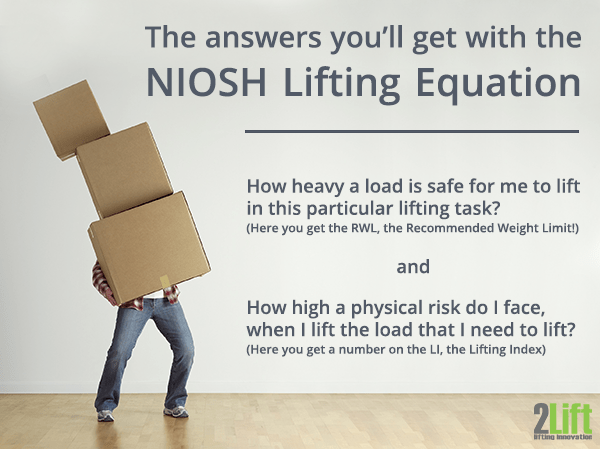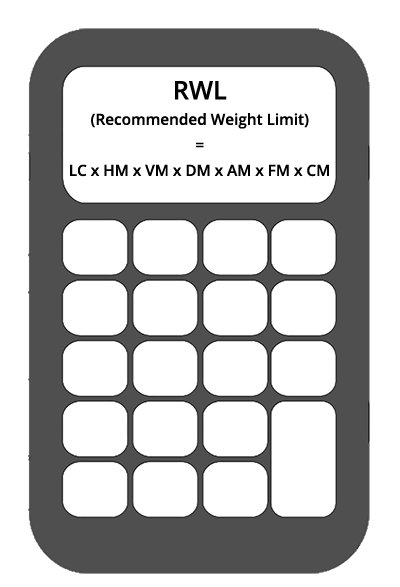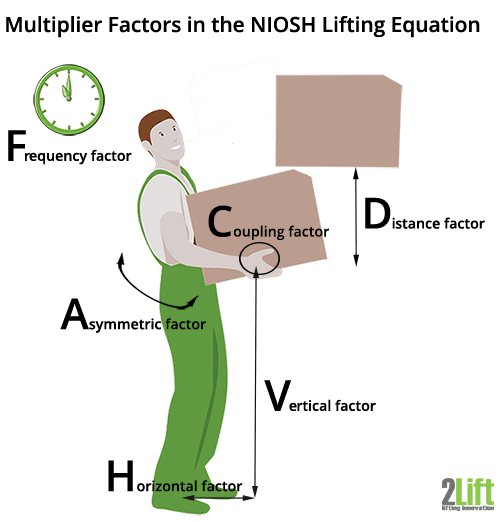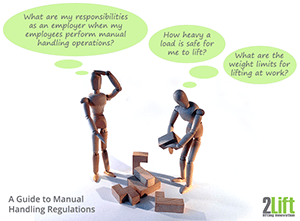NIOSH Lifting Equation
The NIOSH Lifting Equation for Safe Lifting
– Are You Lifting too Heavy a Load? Find the Recommended Weight Limit For Your Lifting Task at Work!
Boiled down to the essence, the NIOSH Lifting Equation for safe lifting can help you answer two questions:

How heavy a load is safe for me to lift in this particular lifting task?
(Here you get the RWL, the Recommended Weight Limit!)
and
How high a physical risk do I face when I lift the load that I need to lift?
(Here you get a number on the LI, the Lifting Index)
Further down this article we’ll explain how you can go about finding the RWL and LI.
First though, we’d like to explain a bit more about the NIOSH Lifting Equation – what characterizes it and how it came about.
What is the NIOSH Lifting Equation?
The NIOSH Lifting Equation is a numeric tool (a clever form of calculator, you could say) that safety and health practitioners can use to evaluate the level of risk associated with a certain type of manual handling action, more specifically the lifting and lowering of loads.
As you are about to discover, the NIOSH Lifting Equation is a rather technical piece of ergonomic risk assessment formula (at least for the common guy, if you’re an engineer, it’s no big deal) because in order to be able to use it correctly, you need to know the specifics of the lifting action in detail, and you shouldn’t be too scared of number crunching either.
Before we get into the lifting equation itself, let’s quickly take a look at how the NIOSH Lifting Equation came about, when it applies and when it doesn’t apply.
The Birth of the Original NIOSH Lifting Equation
The NIOSH Lifting Equation was born in 1981 by NIOSH (The National Institute for Occupational Safety and Health in the U.S.
The purpose of the 1981 NIOSH Lifting Equation was to identify dangerous lifting jobs that could potentially constitute a risk to the musculoskeletal system and thus if ignored, lead to injuries, impairment and / or low back pain (LBP).
What this equation for safe lifting could do was to provide a method for finding safe weight limits for the manual handling of loads. The type of lifting tasks for which it could measure weight limits was fairly simple, namely straight trunk lifting operations known as sagittal lifting tasks.
All this was very well, but the reality of lifting was often more varied and complex, for instance sometimes you’d need to twist the upper body when lifting. Thus the lifting equation was considered too limited as it didn’t embrace enough types of lifting scenarios.
The Revised NIOSH Lifting Equation
Thus 10 years later in 1991, a revised and more comprehensive NIOSH Lifting Equation was developed, and in 1994 this revised edition for safe lifting was made available for use to the general public.
This revised NIOSH Lifting Equation was perceived to be a step up in protecting workers because:
- The maximum recommended load weight had been reduced from 90 pounds (app. 41 kilo) to 51 pounds (app. 23 kilo).
- It applies to a wider variety of lifting operations. The updated equation for safe lifting embraces more lifting variables such as asymmetrical lifting (twisting the trunk) and the quality of hand-holds (the lifting of objects with less than optimal hand gripping possibilities).
However, despite it’s renewed sophistication, the NIOSH Lifting Equation is still only for lifting and not for lifts that include e.g.:
- using only one hand
- work-shifts that last more than 8 hours
- more than minimal carrying / walking (no more than a few steps)
- pushing and / or pulling
- only seated or kneeling positions
- loads considered unstable, e.g. containers with liquid
- more than minimal holding time (no more than a few seconds)
- a high degree of repetitiveness that require significant energy expenditure
- manual handling in ‘poor’ environments e.g. characterized by restricted access, slippery floorings or high / low temperatures
What Exactly Do You Get with the NIOSH Lifting Equation
You get a Recommended Weight Limit (RWL) for:
- a very specific two hand lifting task
- that defines the maximum weight of a load
- that is considered safe to lift for 75% of female workers and 90% of male workers
You also get a number on the Lifting Index (LI) that informs you of the level of risk for MSD (Musculoskeletal Disorders) associated with lifting the load you need to lift. The higher the number, the higher the risk. The goal here is to only have safe lifting tasks with a number score that is less than 1.0.
The NIOSH Lifting Equation Formula

Okay, here is the formula for finding the Recommended Weight Limit for your lifting task:
RWL = LC x HM x VM x DM x AM x FM x CM
In order to find the Recommended Weight Limit (RWL) you need to know the number of seven different factors pertaining to the lifting operation in question.
The first one, LC (Load Constant) is easy. It’s always the same. It’s 51. 51 pounds (app. 23 kilo) represents the maximum load that can be lifted under ideal circumstances.
All the 6 other factors or variables represent complexities that ‘pull’ the recommended weight of the load down in order to ensure a safe lifting operation.
So what are these 6 other variables?
HM (Horizontal Multiplying factor) = The horizontal distance from hands to the centre of the body (defined as mid-point between ankles).
VM (Vertical Multiplying factor) = The vertical distance between the hands (holding the load in the starting position) and the floor.
DM (Distance Multiplying factor) = The vertical distance the load is lifted, measured from starting point to end point.
AM (Asymmetric Multiplying factor) = The angle of asymmetry to the lift. The degree required to twist the body during the lifting task.
FM (Frequency Multiplying factor) = The time between lifts and the overall duration of lifts during a work-shift.
CM (Coupling Multiplying factor) = The quality of the grasp on the load as defined by ‘good’, ‘fair’ or ‘poor’.

The difficult task here is not so much the measuring as it is to understand exactly what is meant by the variables. If you need more information to be able to decipher some of the variables, Ergo-Plus has a fairly good guide here and The Canadian Centre for Occupational Health and Safety also present more in-depth explanations on the factors here.
Finding the LI:
LI = Weight ÷ RWL =
In order to find the LI (Lifting Index) you need to know the weight of the load being lifted and you need the RWL for the lifting task. The LI will give you an indication of the level of risk associated with the lifting task. The higher the LI, the higher the risk of MSD or injuries. Numbers below l.0 are considered safe for most workers.
Ready to Use the Safe Lifting Calculator?
– Online NIOSH Lifting Equation Calculators to Find the RWL
If you have the above variables for the lifting equations, you are now ready to find the RWL.
There are two ways to go about this:
- You can either press the numbers yourself on a calculator
- Or you can choose to use some online NIOSH Lifting Equation calculators.
Here are some online calculators you can try:
The NIOSH Lifting Equation calculator from The Canadian Centre for Occupational Health and Safety.
The NIOSH Lifting Equation calculator from Ergo-Plus.
If You Feel Like Playing with the Equation!
– Examples to Help You Understand How the Different Variables May Affect the RWL
If you’re curious to learn more about how the different variables in the lifting equation affect the recommended weight limit, The Canadian Centre for Occupational Health and Safety has made some great examples for you to follow.
Follow the links below to discover:
- How the horizontal distance may affect the recommended weight limit!
- How the vertical distance may affect the recommended weight limit!
- How the frequency factor may affect the weight limit!
Other Important Resources:
Busy and Want Simpler Calculators?
If the NIOSH Lifting Equation is a bit too data intensive for you, there are several other free safe lifting calculators online, that are both easy and quick to use for busy employer or employee. Se our page on online calculators for more information.
Other Related Pages
Country Specific Pages with Ergonomic Guidelines and Risk Assessment Tools
Go to Ergonomics for an overview of rules and regulations worldwide.
Go to our Homepage.


















